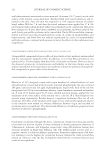NEXT-GENERATION NATURAL BABY BARRIER CREAM FORMULATIONS 181 HLB CALCULATION RESULTS The HLB values of the eight formulations were calculated according to the following formula, and the HLB value of the formulation was chosen as the w/o-type emulsifi er (Dehymuls PGPH HLB: 3.5, Lameform TGI HLB: 3.5). In the BBC-5 formulation, the importance of the emulsifi er selection with the HLB values was confi rmed by using sper- maceti (cetyl ester wax HLB: 11.8) that is not suitable for the w/o-type emulsion “to pro- vide optimization” for control purposes. According to the results, it has been observed that the emulsifi er used in the fi fth formulation was chosen incorrectly (o/w emulsifi er). Considering the HLB values in the other seven formulations, the lipophilic emulsifi er selection was correct, and phase separation was not observed. HLB calculation results are given in Table 3 and Figure 2. MICROBIOLOGICAL ANALYSIS RESULTS Microbiological analysis was performed for 96 h for eight different formulations. Samples that were cultivated on sheep blood agar remained in incubation at 37°C for 4 d, and it was checked whether the microorganisms are reproduced. If there is any microbial reproduction as a result of incubation, further identifi cation work is car- ried out for the determination of the pathogen. Microbial growing was not observed Figure 1. Viscosity result plot of BBC-8 formulation, viscosity/shear rate, and shear stress/shear rate. Table 3 HLB Calculation Chart for All Formulations Name Oil phase HLB PGPH HLB 3.5 PGPH % L-TGI HLB: 3.5 L-TGI % C.E.W.HLB: 11.8 C.E.W. % BBC-1 7,7500 3,5000 49 3,5000 — 11,8000 51 BBC-2 7,7500 3,5000 3,5000 49 11,8000 51 BBC-3 7,4597 3,5000 52 3,5000 — 11,8000 48 BBC-4 7,4378 3,5000 53 3,5000 — 11,8000 47 BBC-5 7,7874 3,5000 0 3,5000 0 11,8000 100 BBC-6 6,1860 3,5000 3,5000 68 11,8000 32 BBC-7 7,9610 3,5000 46 3,5000 11,8000 54 BBC-8 7,9056 3,5000 — 3,5000 47 11,8000 53
JOURNAL OF COSMETIC SCIENCE 182 according to the results in all of the formulations. This result is thought to be due to the use of zinc oxide with antimicrobial properties in all formulations between 7 and 27%. PARTICLE SIZE ANALYSIS AND ZETA POTENTIAL (Ζ) RESULTS A ccording to the results in Table 4, the ideal particle size range was found between 100 and 1,000 nm, and it is considered ideal for effective cosmetic products. Also, polydis- persity index (PDI) 0.5 indicates a homogeneous distribution in all formulations. The zeta potential, particle size (nm), and PDI values of BBC 8- (K13/092) optimum formu- lation were zeta potential = (-30.9 ± 0.72), particle size = (533.2 ± 6.93 nm), and PDI = (0.370 ± 0.03), respectively. Figure 2. HLB and emulsifi er percentage calculation chart of all formulations.
Purchased for the exclusive use of nofirst nolast (unknown) From: SCC Media Library & Resource Center (library.scconline.org)

























































































































